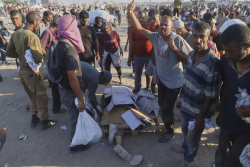Iran’s Cold War-era F-4 fleet performed effectively during the war with Iraq, and Tehran has since invested heavily in maintaining its operational readiness.
Much has been made of the Iranian Air Force’s (IRIAF) stock of Grumman F-14 Tomcat fighters. However, the now-venerable F-14 isn’t the only legendary American aircraft in the Iranian inventory. Iran also continues to operate one of the world’s last active fleets of McDonnell Douglas F-4 Phantoms. Originally delivered to Iran before the 1979 revolution, the F-4 is thoroughly antiquated by modern standards—yet it is expected to serve with the IRIAF into the 2030s.
Iran’s F-4 Phantoms Have Russian and Chinese Upgrades
The Iranian F-4 fleet is over 40 years old. Despite periodic upgrades, the Cold War-era jets have long since fallen into obsolescence relative to modern fighters. However, the fact that Iran has managed to keep about 64 of its F-4s airworthy speaks to an intensive multi-decade effort.
American sanctions implemented after the revolution have made it extremely difficult for the IRIAF to procure spare parts for its American fighters. As a result, Iran has had to rely upon reverse engineering. Of course, the indigenously engineered parts often lack the quality and durability of the originals, making them a short-term fix that requires consistent attention. Iran also relies on clandestine channels, like the black market or NATO intermediaries, to find spare parts. When all else fails, the IRIAF will cannibalize parts from other jets. Keeping the F-4s airworthy is a constant challenge for Iran, requiring ingenuity and intensive effort. Of course, those efforts often fail, as the F-4’s operational readiness is reportedly only around 60 percent.
When the IRIAF F-4s are airworthy, they benefit from upgrades and modernizations to their avionics and sensors. The F-4s feature modern Chinese and Russian radars, digital HUDS, FLIR pods, Helmet-Mounted Sighting System (HMS), and TISEO-style systems. For weapons integration, the F-4s feature the Chinese C-801/C-802 anti-ship missiles, Russian R-73E AAMs, and locally produced Qased precision-guided bombs. In effect, the F-4s are not the same F-4s that the Americans exported to Iran a generation ago; Tehran’s F-4s are more capable, albeit far less capable than modern American or Israeli fighters.
The F-4 Phantom Served Iran Well Against Iraq
The crowning achievement of the IRIAF’s F-4 fleet was arguably the Iran-Iraq War, which lasted from 1980 to 1988. IRIAF F-4s were tasked with deep strike and interdiction missions, targeting Iraqi infrastructure like airfields, oil refineries, and supply depots. Famous missions include Operation Scorch Sword (1980), in which the IRIAF launched a preemptive strike on Iraq’s Osirak nuclear reactor, and the H3 Raid (1981), in which Iran conducted a long-range strike deep into western Iraq that destroyed 40-plus Iraqi aircraft on the ground. The IRIAF F-4s were also used in air superiority roles, engaging with Iraqi MiG-21s, MiG-23s, and Su-20/22s in dogfights. However, the F-4s were eventually outclassed by newer Iraqi aircraft like the MiG-25 and Mirage F1.
Overall, the F-4 was successful early in the Iran-Iraq War, but as maintenance challenges mounted and experienced pilots were lost, the F-4’s success rate dropped off. Nevertheless, largely out of a lack of alternatives, the F-4 has stayed in service in the generation since the Iran-Iraq War ended. Iranian F-4s most recently participated in the Syrian Civil War and the campaign against ISIS. Reports indicate the IRIAF F-4s will likely remain in service for another decade, even though the plane’s moment of primary relevance passed half a century ago.
About the Author: Harrison Kass
Harrison Kass is a Senior Defense and National Security Writer at The National Interest. Kass is an attorney and former political candidate who joined the US Air Force as a pilot trainee before being medically discharged. He focuses on military strategy, aerospace, and global security affairs. He holds a JD from the University of Oregon and a master’s in Global Journalism and International Relations from NYU.
Image: Wikimedia Commons.
















